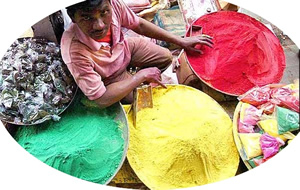By Rama Gaind.

India Gate, in New Delhi, commemorates the 70,000 Indian soldiers who lost their lives fighting for the British Army during World War I. Photo: Rama Gaind
It was just a brief visit to New Delhi, India, but long enough to again be able to appreciate – now that we can travel overseas again – the spirit and significance of Holi – the Festival of Colours.
That’s usually a time when life is a riot of vibrant shades which has an impact on countless aspects of our daily lives from the way we decorate our homes and what we eat to the clothes we wear.
Everyone was putting on their most lively side upfront because the season was about celebrating the brighter hues of life with our near and dear ones. Over two days in mid-March (though celebrations were rather subdued this year), the streets were alive with people rejoicing, spraying each other with coloured liquid and exchanging gifts.
Stories abound of the origins of Holi (also called holika or phagwa) which is a harvest celebration marking the climax of spring. It carries India into the bright days of summer. The most widely held belief is that Holi marks the day when the devotee of Lord Vishnu, Bakt Prahlad, seated on the lap of demoness Holika, was saved from a fire by God.
Bonfires are lit, marking both the end of winter and the death of evil, and proceeds from the seasonal harvest – including grains and coconuts – offered to the flames. The next day, dhuleti involves throwing plenty of coloured powder, colourful water, offering prayers, fast and feasting. People have fun dancing and gambling, but there are some who prefer to steer clear of the streets to avoid the enthusiastic celebrations and keep away from getting stained with dye.
Few sweets are intrinsically linked to a festival as gujiya is with Holi. Generations have enjoyed this sweetmeat during the spring festival made from maida (white flour) stuffed with khoya or mawa (dairy food), almonds, raisins and cardamom
Iconic sites

Proud painted young faces celebrate Holi. While some people rub coloured powders onto each other’s faces, some children find using water pistols is much more fun!
While the spirit of celebration showcases the shifting panorama of life, sights, movement and feelings, the urge to explore cannot be contained. There’s a fascinating charm about both Old and New Delhi which you have to dig deep to uncover. First impressions can be off-putting, but underneath the chaotic façade hides the inner peace of a city that’s steeped in history, has a wealth of culture, fine architecture and human diversity and a capital that will delight epicurean tastebuds.
Not much is made of the fact that during the British Raj, Calcutta was the capital of India until 1911. Due to its historic and cultural importance, the capital was shifted from Calcutta to Delhi by the then Emperor of India, George V.
Overlaying the site of seven ancient cities, New Delhi was laid out to the south of the Old City which was constructed by Mughal Emperor Shah Jahan – who gave us the fabled Taj Mahal and the Motī Masjid (Pearl Mosque), both in Agra, and the Jāmiʿ Masjid and Red Fort in Delhi. Hence, the city includes many historic monuments like Jantar Mantar and the Lodhi Gardens.
A leading 20th century British architect Edwin Lutyens planned much of New Delhi.
It is said that Lutyens laid out the central administrative area of the city as a testament to Britain’s imperial pretensions.
At the heart of the city is the magnificent Rashtrapati Bhawan (then known as Viceroy’s House) which sits atop Raisina Hill. It is the official residence of the President of India at the western end of Rajpath. Also known as King’s Way, Rajpath stretches from India Gate to Rashtrapati Bhawan. The Secretariat which houses various ministries of the Government of India, flanks out of Rashtrapati Bhawan. Parliament House, designed by Herbert Baker, is located at the Sansad Marg, which runs parallel to the Rajpath.

The historic Red Fort in Old Delhi. Photo: Rama Gaind
There are eight forts in Delhi that give a peek into the city’s glorious past. The Red Fort or Lal Qila is a historic fort in Old Delhi, that served as the main residence of the Mughal Emperors. It is a Mughal fortress which surrounds an ancient city. The Red Fort was designated a UNESCO World Heritage site in 2007 as part of the Red Fort complex.
The 42-metre-high India Gate, in New Delhi, commemorates the 70,000 Indian soldiers who lost their lives fighting for the British Army during the World War I.
Originally called the All India War Memorial, it’s an ‘Arc-de-Triomphe’-like archway in the middle of a crossroad that attracts an endless stream of tourists on a daily basis.
Sightseeing highlights
One of the most popular Indian monuments and one of the first stops on most itineraries, India Gate is famous for its majestic structure, beautiful fountains that have been carved in sandstone and plush lawns. The gate was built by Lutyens to commemorate the thousands of Indian soldiers who died during World War I and during the Afghan War. The names of each soldier have been inscribed on its walls and an eternal flame burns below the gate ever since 1971. An ideal time to view it is in the evening, once the structure is bathed in the surrounding lights

Shopkeepers do good business for Holi during March.
The Qutb Minar complex features monuments and buildings from the Delhi Sultanate at Mehrauli. Considered to be the tallest brick minaret in the world, Qutub Minar is an exciting example of Indo-Islamic architecture. It features five distinct storeys, each storey covered with writings from the Koran and intricate carvings.
There is so much to see and do in the capital. Apart from indulging in shopping sprees and tasting the local cuisine, you should visit India Gate, explore the Red Fort, go to Qutub Minar, spend some time at Humayun’s Tomb (famous as the most captivating and perfectly proportioned mausoleum in Delhi), pay one’s respect at Raj Ghat (a memorial dedicated to Mahatma Gandhi), be awe-inspired in Akshardham Temple, relax at the enchanting Lodi Gardens (considered to be one of the most favorite hangouts in Delhi), walk around the Akshardham Temple, which is recognised by the Guinness Book of World Records as the ‘largest comprehensive Hindu temple’ in the world. Considered to be one of the most recognisable landmarks in Delhi because of its unique architecture, do not miss seeing the Lotus Temple which is a sanctuary for those looking for some peace and quiet.
Whenever you travel, do take note of official advice. As countries open their borders, experts do advise caution since entry requirements do vary, risk categories do change and it’s advisable to first check entry details before travelling to the destination.
Holi reminds us that the time is now perfect to be recharged, to be coloured, to renew love and to revitalise our energies – all in sync with nature. The multi-coloured hues symbolise the vivid, passionate pulse of life that signifies vitality.
DETAILS BOX
Qantas flies direct to New Delhi, India
Airfare/accommodation packages







